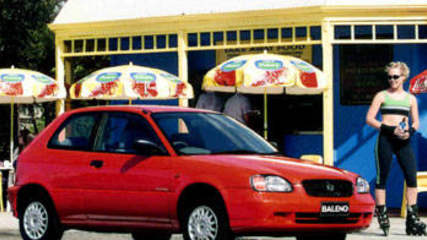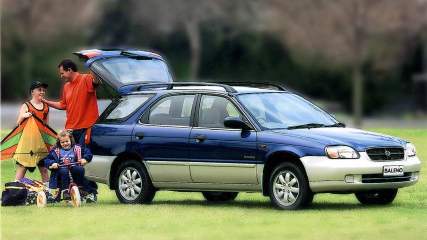Used Suzuki Baleno review: 1995-2001
By Graham Smith · 29 Jan 2009
The Baleno was Suzuki’s move in to another, larger segment of the market than those in which it had carved out a nice little niche for itself. But it was as if it had misread the market and arrived at the conclusion that small car buyers wanted bland.While it was very definitely bland on the outside Suzuki’s engineering quality meant it was well designed and built and that has meant that it’s cheap to run and little goes wrong with it.It was ridiculed as an ugly duckling when new, but low running costs and few mechanical woes now make the Suzuki Baleno an attractive used car buy. Those familiar with models like the Swift GTi and the four-wheel drive Vitara would have been mystified by the Baleno. While the Swift and Vitara were great little cars that won a passionate following, the Baleno was so bland and uninspiring it could have come from another carmaker.Suzuki needed to do something special to make the Baleno stand out in a market segment crowded with proven performers like the Toyota Corolla, Ford Laser, Nissan Pulsar and Mazda 323. It didn’t.The Baleno wasn’t a bad car by any measure; it was simply that it was lost in its own mediocrity when it needed to be much better than the opposition just to get noticed.Its styling didn’t help, no matter whether it was the three-door hatch, four-door sedan or wagon. Whichever, its looks were bland and boring, the lines soft and soppy, the curves rounded without clear definition. The best thing that could be said about the Baleno’s looks was that they were inoffensive.The Baleno’s main engine was a sickly 1.6-litre single overhead camshaft four-cylinder unit that produced 73 kW at 6000 revs along with 127 Nm at 3000 revs. For those wanting more there was a 1.8-litre double overhead camshaft engine in the meant-to-be sporty GTX, which made a more inspiring 89 kW at 6200 revs and 152 Nm at 3400 revs.The transmission choices were a five-speed manual and four-speed auto, both of which were competent and got the job done with little fuss.Ride comfort was acceptable over most types of road; the handling was also well balanced and reasonably assured if not inspiring.Inside, the Baleno was reasonably well equipped. The base model GA had power steering, cloth trim, four-speaker sound and a split-fold rear seat, the GS had sports seats, height adjustment for the driver’s seat and colour-matched bumpers, while the GLX also had remote central locking. At the top of the range sat the GTX with its alloy wheels, rear spoiler, sports seats, velour trim, central locking, power mirrors, power windows and six-speaker sound.The major criticism of the Baleno was its lack of refinement when compared to its main rivals. Interior noise, from engine and wind, was quite high.A facelift in 1999 brought a new look with new front bumper, headlights, grille and bonnet, but little else.Generally Suzukis fare well in terms of reliability, which says heaps for the design and development that has gone into them. The Baleno is no different.Owners report minor problems only, the engines and gearboxes stand up well in service if maintained properly.Look for a service record that shows regular oil and oil filter changes, and a cam timing belt change around 90,000 km.Tyres and brakes appear to last well. Brake pads typically need changing at 60,000-70,000 km, tyres from 60,000 to 80,000 appears the norm.The Baleno is rated only average in crash protection in the annual survey of used car crashes.While the GTX had dual front airbags the rest of the range missed out.David Hicks bought his 1999 Baleno sedan cheap at auction with 45,000 km on the odo and reckons it’s the best car he’s ever owned. It is light on fuel, light to drive and change gears, and is quiet inside especially with the dash mat he’s used to reduce the engine noise.David Borton is also pleased with the 1999 Suzuki Baleno he bought new. At the time he wanted a car that would be cheap to run for a couple of years before he disposed of it and opted for the Baleno after his experience with a Suzuki Vitara. Six years and 99,000 km later he still has it. The reason he’s stuck with it are the running costs, which he says are very low. Fuel consumption is normally between 7.5 and 8.0 L/100 km. His only problem has been a leak from the top of the windscreen and a few dash rattles.Bill Callaghan owns a 2000 Baleno manual wagon, which he says continues to give excellent service after 80,000 km trouble free kilometres. He rates the performance and handling, and road feel good with the power steering, and the consumption frugal at 8.0-10.0 L/100 km around town and 6.7 L/100 km on the highway.• Good fuel consumption• Commendable reliability• Good tyre and brake life• Mundane looks• Interior noise level high• Average resale valueWorth considering if you want a car with low running costs and you’re not worried about standing out from the crowd.








